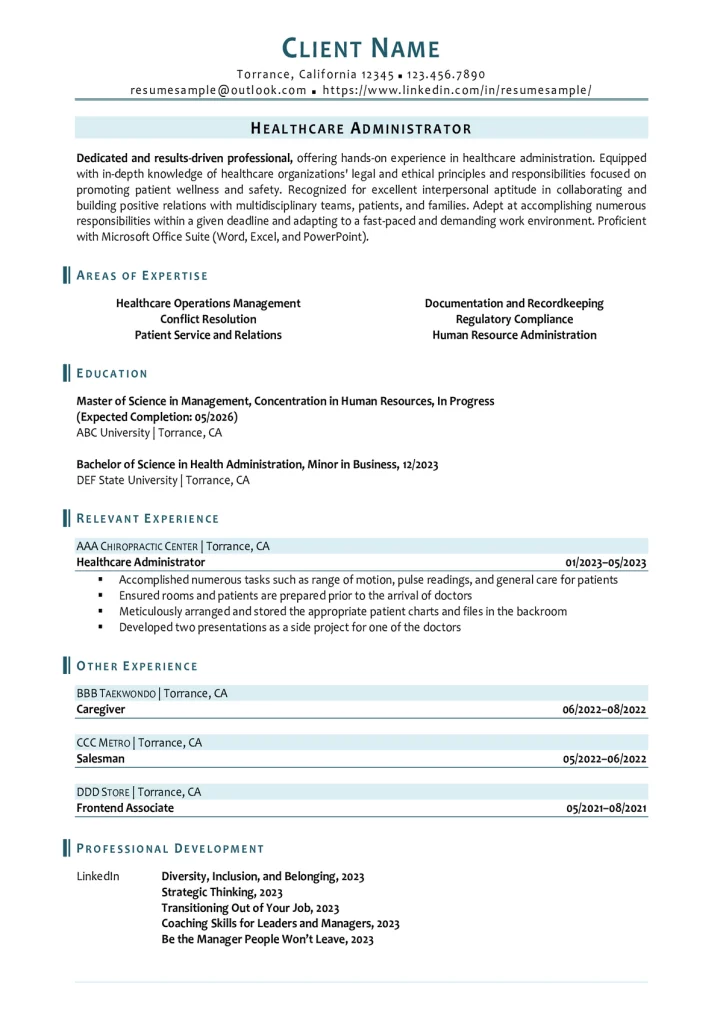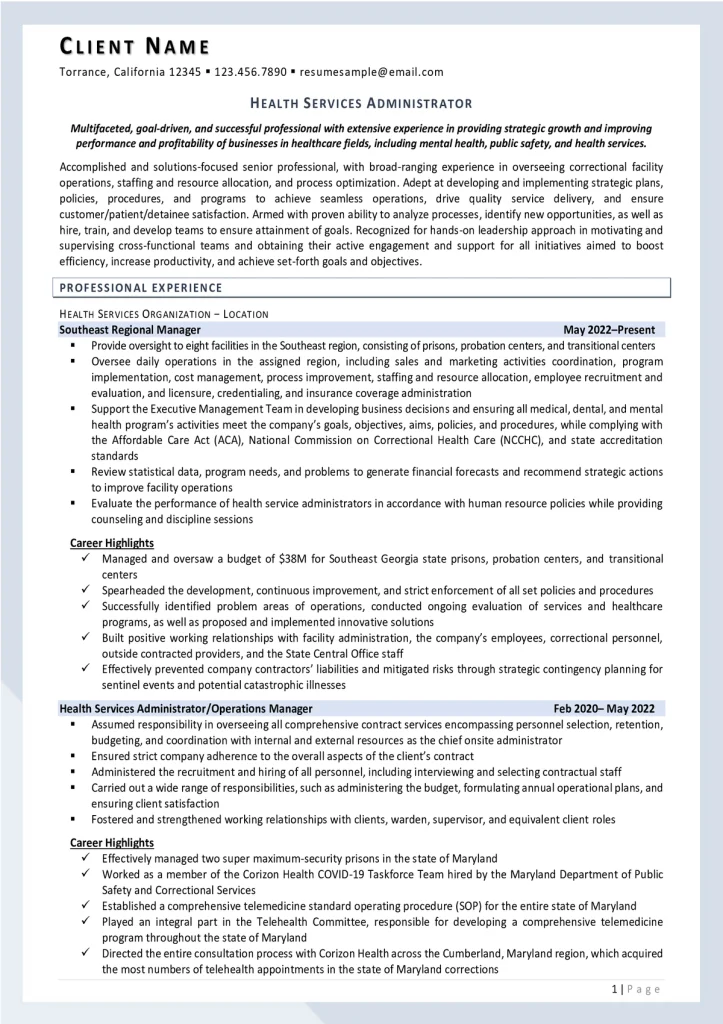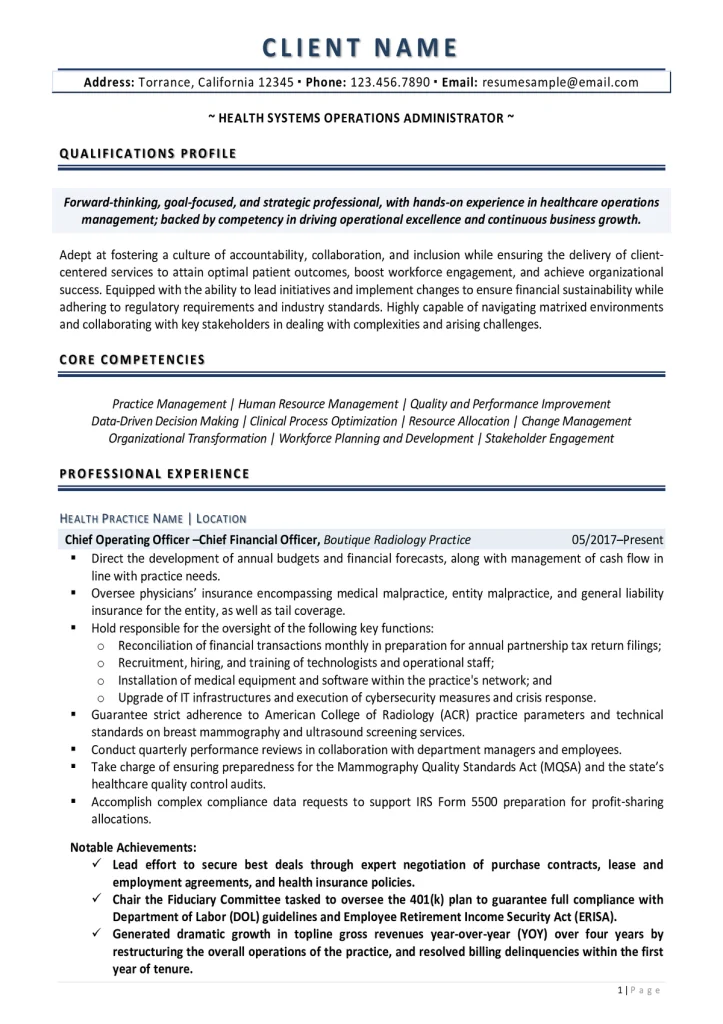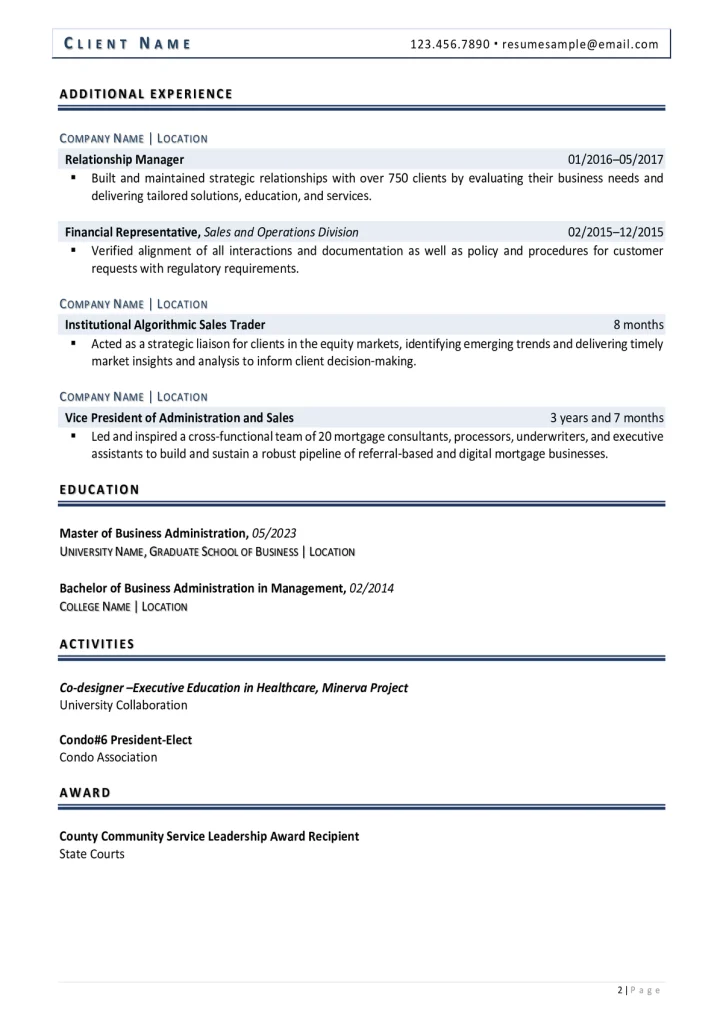Healthcare administrators often face complex challenges when translating their leadership and operational expertise into a clear, measurable, and modern healthcare administrator resume. Between meeting applicant tracking system (ATS) standards, emphasizing compliance knowledge, and quantifying patient care impact, many find it difficult to craft a document that fully reflects their strategic contributions to healthcare delivery.
Designed for job seekers targeting management roles across hospitals, clinics, and long-term care facilities, this comprehensive resource offers expert strategies for developing an EEAT-compliant healthcare administrator resume. It provides actionable guidance on format, skills, metrics, and market-driven keywords to help healthcare professionals capture recruiter attention and advance in a competitive 2025 job market.

Understanding the Healthcare Administrator Role
A healthcare administrator manages the business operations of medical facilities. Their roles vary widely — from department managers in community hospitals to executive directors of large health systems — but all share some core responsibilities:
- Oversee budgeting, staffing, process optimization, and strategic planning to align organizational performance with regulatory and financial standards.
- Lead interdisciplinary teams to improve service delivery and patient experiences.
- Implement federal and state healthcare policies, ensuring compliance with Health Insurance Portability and Accountability Act (HIPAA) and Centers for Medicare & Medicaid Services (CMS) regulations.
The evolving landscape of U.S. health systems in 2025 demands leaders who are equipped with:
- Keen understanding of data-driven decision-making, digital transformation, and value-based care models.
- A blend of clinical awareness and financial acumen, prioritizing measurable achievements in cost reduction, workflow improvement, and patient satisfaction.
- Technical proficiency in electronic health records (EHR) systems, complemented by agile leadership, capable of modernizing practices while securing financial sustainability.
A well-structured healthcare resume should reflect these evolving expectations by featuring measurable outcomes and operational leadership that align with institutional goals.
Essential Elements of a Healthcare Administrator Resume
Each healthcare administrator resume should follow a structure that enables recruiters and automated systems to quickly identify qualifications and verify experience alignment. A well-designed layout should feature the following components, presented clearly and in reverse chronological order:
- Contact Information: Full name, professional title, phone number, email address, and LinkedIn profile. Including a professional URL enhances digital presence verification.
- Professional Summary: A concise section summarizing years of leadership experience, organizational size, areas of specialization (e.g., hospital operations, regulatory compliance, patient services), and quantified accomplishments.
- Core Competencies: Targeted skills that align with job descriptions, such as healthcare finance, EMR management, HIPAA compliance, and process optimization. Keywords should match the language used in current industry postings.
- Professional Experience: A results-focused listing of previous roles. Each entry should detail operational improvements, strategic initiatives, or measurable team outcomes achieved under the candidate’s direction.
- Education and Certifications: Degrees such as a Master of Health Administration (MHA), Master of Public Health (MPH), or MBA in Healthcare Management are standard. Certifications like FACHE (Fellow of the American College of Healthcare Executives), Certified Medical Manager (CMM), or CPR/First Aid credentials further enhance credibility.
- Technology Proficiency: Familiarity with EHR platforms, healthcare analytics tools, and compliance tracking systems, including Epic, Cerner, and Tableau, positions administrators as technology-forward leaders.
This section not only establishes core sections but also illustrates formatting consistency. Recruiters require clarity, while ATS parsing systems require optimized headers and keyword-rich content. Using job-relevant terms like “clinical operations management,” “regulatory compliance,” and “patient flow optimization” in a healthcare administrator resume increases match rates during automated resume scans.
Formatting and Structure for Maximum Impact
Presentation and readability have a direct impact on how far a healthcare administrator resume advances in the hiring process. A clean, professional layout with logical hierarchy allows both automated systems and human reviewers to identify value instantly. The preferred structure for 2025 remains a hybrid or combination format, which balances skill emphasis with measurable career progression.
- Professional Summary First: Recruiters in healthcare review dozens of resumes daily. Placing an impactful summary paragraph at the top creates a clear career story and differentiates the candidate as leadership-ready. This section should convey how the applicant improves operational efficiency or enhances quality metrics.
- Skills Cluster Modularity: Grouping competencies into thematic clusters—such as “Healthcare Management,” “Financial Oversight,” and “Technology Integration”—makes it easier for employers to evaluate the candidate’s expertise.
- Quantified Bullet Points: Each professional experience entry should highlight metrics, such as percentage improvements in patient satisfaction scores, reductions in operating costs, or revenue growth. Quantification builds credibility and meets modern recruiters’ preference for evidence-based results.
- Sectional Balance: Utilization of white space, consistent fonts, and strategic bolding ensures better visual balance. Healthcare administrator resume tends to include dense information, so controlled formatting improves skimmability.
- ATS-Friendly Optimization: Embedded keywords related to the healthcare field improve compatibility with applicant tracking systems. This ensures the healthcare administrator resume ranks higher when screening algorithms match job requisitions with uploaded profiles.
The tone across the document should remain professional and achievement-oriented. Phrases like “implemented,” “directed,” and “optimized” demonstrate executive leadership, while integrating financial and operational outcomes connects management decisions directly to organizational results.
Key Skills to Highlight in a Healthcare Administrator Resume
Employers hiring healthcare administrators prioritize versatile professionals capable of balancing fiscal responsibility, workforce management, and quality outcomes. The following competencies represent essential skill segments in modern healthcare administration roles:
| Skill Category | Representative Skills |
|---|---|
| Operational Leadership | Departmental management, process improvement, team coordination, policy enforcement |
| Financial Management | Budgeting, cost control, revenue cycle management, strategic allocation of resources |
| Regulatory Compliance | HIPAA, Joint Commission accreditation, OSHA compliance, quality assurance audits |
| Technology Integration | EHR systems (Epic, Cerner, Meditech), healthcare analytics, cybersecurity in healthcare settings |
| Patient Service Innovation | Patient satisfaction strategies, care coordination, cultural competence, patient safety initiatives |
Demonstrating these capabilities in healthcare administrator resume distinguishes candidates as operationally strategic and ethically grounded. Including both quantitative outcomes and technical proficiencies positions professionals as well-rounded leaders attuned to both clinical quality and fiscal accountability. Data literacy, particularly in predictive analytics or population health management, further supports an applicant’s relevance in 2025’s technology-led healthcare administration environment.
Education, Certifications, and Credentials
Healthcare organizations expect administrators to hold advanced academic preparation. Most positions require at least a bachelor’s degree in health administration, health policy, or business administration, while senior management roles often prioritize professionals with graduate degrees. The most impactful healthcare administrator resume complements academic achievements with continuing professional education and certifications that demonstrate ongoing compliance and leadership readiness.
| Credential Type | Examples and Recognized Bodies |
|---|---|
| Graduate Degrees | Master of Health Administration (MHA), Master of Public Health (MPH), MBA in Healthcare Management |
| Executive Certifications | FACHE (American College of Healthcare Executives), Certified Medical Practice Executive (MGMA) |
| Regulatory and Compliance Training | HIPAA Compliance Certification, Six Sigma Green or Black Belt for Operational Efficiency |
Listing education toward the end of the healthcare administrator resume ensures recent achievements and leadership roles remain top-focused. Including credentials in active status demonstrates commitment to continuous improvement — a key competency in healthcare leadership recognized by institutions seeking transformational managers.
Quantifying Achievements and Demonstrating Impact
Healthcare administrators drive organizational value through metrics. Employers rarely rely on subjective claims alone; they instead prioritize evidence-backed success. Every bullet within the professional experience section in the healthcare administrator resume should communicate measurable outcomes tied to financial, operational, or patient-care goals.
- “Increased patient satisfaction ratings by 22% through implementation of real-time feedback systems.”
- “Reduced operational costs by $1.2M annually by renegotiating vendor contracts and optimizing staffing.”
- “Spearheaded EHR migration across five departments, achieving full adoption six weeks before deadline.”
- “Improved hospital readmission rates by 12% through enhanced discharge planning and patient follow-up protocols.”
Metrics also enhance authenticity. Recruiters assess not only what was done but also the scope and magnitude of success. Tying results to strategic objectives — such as efficiency, sustainability, or care expansion — reinforces executive-level foresight. Healthcare administrators who quantify achievements effectively demonstrate their tangible contributions to institutional excellence.
Common Resume Mistakes to Avoid
Even experienced professionals occasionally overlook resume elements that can delay or derail applications. In healthcare administration, precision and compliance are particularly critical. Avoiding these common missteps in the healthcare administrator resume ensures the document meets both human and algorithmic review standards:
- Overly Generic Summaries: Failing to tailor the summary weakens alignment with a facility’s operational priorities. Hiring managers prefer summaries that clearly reflect experience scale and departmental oversight.
- Absence of Quantifiable Results: Listing duties without metrics misses an opportunity to prove impact. Each position should reveal measurable business or quality improvement outcomes.
- Improper Acronym Use: Acronyms must be spelled out on first mention to ensure ATS systems correctly recognize them. For instance, use “Electronic Health Records (EHR)” before continuing with “EHR.”
- Complex Formatting: Graphical elements or columns can confuse ATS scanners. Using straightforward bullet formatting and standard fonts ensures compatibility across electronic review systems.
- Omitting Compliance Areas: Hiring panels in healthcare scrutinize knowledge of regulatory frameworks. Failing to mention HIPAA, CMS compliance, or accreditation processes weakens administrative credibility.
Precision and clarity remain paramount. A carefully curated healthcare administrator resume should read as both data-driven and executive-level, signaling mastery of leadership, compliance, and measurable operations.
Salary Outlook and Career Prospects for Healthcare Administrators
Healthcare administration remains one of the most stable and financially rewarding management fields in the U.S. According to the BLS, median annual wages for medical and health services managers continue to surpass national averages, reflecting the critical nature of administrative leadership in medical organizations. Salary ranges vary based on organizational size, specialization, and geography, with executives in metropolitan hospitals and integrated health systems earning well into six figures annually.
| Industries | Average Annual Salary (USD) |
|---|---|
| Entry-Level (0–3 years) | $70,000 – $95,000 |
| Mid-Level (4–9 years) | $95,000 – $135,000 |
| Senior/Executive (10+ years) | $140,000 – $200,000+ |
The U.S. Bureau of Labor Statistics (BLS) also reported that medical and health services managers continue to experience strong job growth, with employment projected to increase faster than average through the decade as aging populations and technological advancements expand healthcare demand.
| Job Title | 2024 Employment | 2034 Projected Employment | 2024-2034 Growth |
| Healthcare Administrator | 616,200 | 759,100 | 23% or 142,900 |
These figures emphasize the growing demand for qualified professionals capable of managing regulatory complexity and operational scale. Professionals pursuing leadership positions should regularly update credentials and align resumes with current healthcare innovation trends such as telehealth expansion, sustainability initiatives, and AI-assisted patient care analytics.
Optimizing Healthcare Administrator Resume for ATS and AI Recruitment Systems
Modern recruiting relies heavily on automated scanning tools that prioritize relevance and structure over creativity. To ensure visibility, healthcare administrators should engineer their resumes for compatibility with applicant tracking systems. This involves embedding position-relevant keywords, maintaining standardized formatting, and ensuring consistent verb usage.
- Keyword Alignment: Echo critical phrases from job ads—such as “healthcare operations,” “regulatory compliance,” and “budgetary oversight.”
- Standardized Titles: Use recognizable industry job titles like “Healthcare Administrator,” “Operations Director,” or “Practice Manager.”
- Readable File Format: Submitting in Word (.docx) over PDF ensures seamless ATS parsing unless specified otherwise.
- Consistent Structure: Each section title should mirror standard ATS-recognized headers like “Experience,” “Education,” or “Certifications.”
Furthermore, integrating AI-friendly language patterns contributes to higher ranking within LLM-assisted resume screeners. Concise bullet points, active verbs, and quantified results communicate value efficiently and maintain contextual clarity across multiple parsing algorithms now standard within healthcare recruitment platforms.
Examples of Healthcare Administrator Resume at Every Career Stage
For an aspiring healthcare administrator, this resume showcases foundational skills and experiences that demonstrate a commitment to enhancing patient care and operational efficiency within healthcare settings.
Entry-Level Healthcare Administrator Resume

This mid-level healthcare administrator resume highlights a robust blend of management experience and strategic insight, illustrating a proven track record of optimizing healthcare operations and improving patient outcomes.
Mid-Level Healthcare Administrator Resume


This executive-level healthcare administrator resume exemplifies leadership excellence and strategic vision, reflecting a deep expertise in driving organizational success and transformative initiatives in complex healthcare environments.
Senior or Executive Level Healthcare Administrator Resume


Case Example: Transforming a Healthcare Administrator Resume
Before: A mid-level healthcare manager submitted a generic resume listing day-to-day responsibilities without quantifiable elements or modern ATS optimization. The layout relied on dense text blocks, lacked measurable metrics, and failed to mention critical technologies such as EHR or revenue cycle systems.
Strategy: The document was restructured to include a strategic summary and reordered sections highlighting operational achievements. The rewrite incorporated strong action verbs like “implemented,” “streamlined,” and “negotiated.” Quantitative data points reflecting reductions in administrative expenses and improvements in departmental turnaround times were inserted. Formatting was aligned with ATS-readability standards.
After: The revised healthcare administrator resume increased recruiter interest, leading to a 40% improvement in interview callback rates. It demonstrated convincing leadership competencies, emphasized compliance expertise, and articulated measurable impact—all of which positioned the professional for advancement into a director-level administrative role.
Build a Strategic Resume That Elevates Career Opportunities
A healthcare administrator resume represents not only experience but also operational philosophy and institutional value delivery. By quantifying impact, maintaining ATS compatibility, and demonstrating ongoing professional development, administrators ensure continued market competitiveness. Many professionals enhance career outcomes by working with healthcare resume writing services that refine branding, strengthen keyword strategy, and deliver employer-aligned, quantifiable achievements.
Frequently Asked Questions
What should be included in a healthcare administrator’s resume?
A healthcare administrator’s resume should include a professional summary, skills section, quantified achievements, certifications, and academic credentials. It must highlight operational leadership, compliance management, and measurable outcomes such as cost containment or patient satisfaction improvement.
Which keywords are important for ATS optimization in healthcare resumes?
Relevant keywords include “healthcare operations,” “budget management,” “EMR/EHR systems,” “regulatory compliance,” “patient safety,” and “medical staff leadership.” Integrating these naturally throughout the resume enhances ATS ranking and recruiter discoverability.
How long should a healthcare administrator’s resume be?
Most healthcare administrator resumes perform best at two pages. This length allows detailed descriptions of leadership accomplishments, compliance outcomes, and technical proficiencies without overwhelming recruiters or automated parsing systems.
Is it necessary to include a cover letter when applying for healthcare leadership positions?
While not always required, a tailored cover letter personalizes the application. It contextualizes career highlights and demonstrates alignment with an organization’s mission, offering a narrative complement to the quantitative focus of the resume.
What salary can healthcare administrators expect in 2025?
Healthcare administrators can anticipate average earnings between $95,000 and $135,000 annually for mid-level roles, with senior executives earning upwards of $200,000 depending on organization size and location, according to the U.S. Bureau of Labor Statistics.








